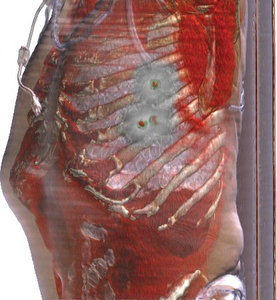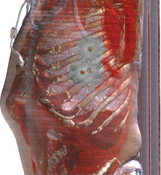Information
- Publication Type: Invited Talk
- Workgroup(s)/Project(s):
- Date: 2005
- Event: Dissertation Thesis Report
- Location: University of Siegen, Germany
- Conference date: 11. November 2005 –
Abstract
In this talk several expressive visualization techniques for volumetric data are presented. The key idea is to classify the underlying data according to its prominence on the resulting visualization by importance value. The importance property drives the visualization pipeline to emphasize the most prominent features and to suppress the less relevant ones. The suppression can be realized globally, so the whole object is suppressed, or locally. A local modulation generates cut-away and ghosted views because the suppression of less relevant features occurs only on the part where the occlusion of more important features appears.Features within the volumetric data are classified according to a new imension denoted as object importance. This property determines which structures should be readily discernible and which structures are less important. Next, for each feature various representations (levels of sparseness) from a dense to a sparse depiction are defined. Levels of sparseness define a spectrum of optical properties or rendering styles. The resulting image is generated by ray-casting and combining the intersected features proportional to their importance. An additional step to traditional volume rendering evaluates the areas of occlusion and assigns a particular level of sparseness. This step is denoted as importance compositing. Advanced schemes for importance compositing determine the resulting visibility of features and if the resulting visibility distribution does not correspond to the importance distribution different levels of sparseness are selected.
The applicability of importance-driven visualization is demonstrated on several examples from medical diagnostics scenarios, flow visualization, and interactive illustrative visualization.
Additional Files and Images
Weblinks
No further information available.BibTeX
@talk{diss-thesis-siegen,
title = "Importance-Driven Expressive Visualization",
author = "Ivan Viola",
year = "2005",
abstract = "In this talk several expressive visualization techniques for
volumetric data are presented. The key idea is to classify
the underlying data according to its prominence on the
resulting visualization by importance value. The importance
property drives the visualization pipeline to emphasize the
most prominent features and to suppress the less relevant
ones. The suppression can be realized globally, so the whole
object is suppressed, or locally. A local modulation
generates cut-away and ghosted views because the suppression
of less relevant features occurs only on the part where the
occlusion of more important features appears. Features
within the volumetric data are classified according to a new
imension denoted as object importance. This property
determines which structures should be readily discernible
and which structures are less important. Next, for each
feature various representations (levels of sparseness) from
a dense to a sparse depiction are defined. Levels of
sparseness define a spectrum of optical properties or
rendering styles. The resulting image is generated by
ray-casting and combining the intersected features
proportional to their importance. An additional step to
traditional volume rendering evaluates the areas of
occlusion and assigns a particular level of sparseness. This
step is denoted as importance compositing. Advanced schemes
for importance compositing determine the resulting
visibility of features and if the resulting visibility
distribution does not correspond to the importance
distribution different levels of sparseness are selected.
The applicability of importance-driven visualization is
demonstrated on several examples from medical diagnostics
scenarios, flow visualization, and interactive illustrative
visualization. ",
event = "Dissertation Thesis Report",
location = "University of Siegen, Germany",
URL = "https://www.cg.tuwien.ac.at/research/publications/2005/diss-thesis-siegen/",
}


